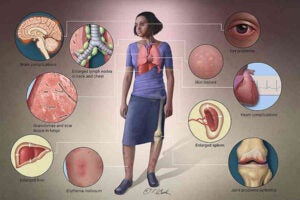Clinical Presentation, Symptoms, and Diagnosis of Sarcoidosis
What are the symptoms of sarcoidosis?
 Some people with sarcoidosis will not have any symptoms at all. When present, the symptoms of sarcoidosis will depend on where in your body granulomas form. Most people will have lung symptoms, but you can also have symptoms in your skin, eyes, lymph nodes, joints, heart, and brain if these organs are affected. Some people may have general feelings of fatigue or being unwell and these can persist even after organ involvement has resolved.
Some people with sarcoidosis will not have any symptoms at all. When present, the symptoms of sarcoidosis will depend on where in your body granulomas form. Most people will have lung symptoms, but you can also have symptoms in your skin, eyes, lymph nodes, joints, heart, and brain if these organs are affected. Some people may have general feelings of fatigue or being unwell and these can persist even after organ involvement has resolved.
General Symptoms
- Extreme tiredness (Fatigue)
- Unexplained weight loss
- General feelings of being unwell (malaise)
- Fever
- Night sweats
- Joint and muscle aches and pains
Symptoms of sarcoidosis in your lungs (Pulmonary Sarcoidosis)
- Cough
- Shortness of breath (dyspnea)
- Chest pain
- Wheezing
Symptoms of sarcoidosis in your heart (Cardiac Sarcoidosis)
- Chest pain
- Irregular heartbeat (arrhythmia)
- Fluttering heartbeat (palpitations)
- Shortness of breath
- Dizziness and fainting spells (syncope)
- Swelling in your legs from heart failure
Symptoms of sarcoidosis in your skin (Cutaneous sarcoidosis)
- Lumps or bumps on your skin especially around scars or tattoos (papules)
- Lumps or bumps under your skin (subcutaneous nodules)
- Discolored (darker or lighter) skin patches (plaques)
- Reddish raised patches on your nose or cheeks (lupus pernio)
- Red, painful bumps on your shins (erythema nodosum)
Symptoms of sarcoidosis in your eyes (Ocular sarcoidosis)
- Blurred vision or loss of vision
- Red or swollen eyes
- Pain in your eyes
- Increased light sensitivity
- Floaters in your eyes
- Dry and/or watery eyes
Symptoms of sarcoidosis in your brain and nervous system (Neurosarcoidosis)
- Headaches
- Seizures
- Stroke-like symptoms (weakness in one or more parts of your body)
- Weak or paralyzed facial muscles
- Gait instability
- Numbness and tingling in your feet and hands (neuropathy)
Symptoms of sarcoidosis in your joints and bones (Osseous sarcoidosis)
- · Bone and joint pains
- · Joint swelling
- · Fractures with minimal trauma (Pathological fractures)
Diagnosis and Tests
How is sarcoidosis diagnosed?
Sarcoidosis is diagnosed by a combination of physical exam, imaging (such as a chest X-ray, computed tomography (CT) scan, or magnetic resonance imaging (MRI)), and biopsy of the affected organ (most commonly the lungs). Sarcoidosis is a diagnosis of exclusion which means that your doctor may need to perform additional testing to exclude other possible causes of your symptoms.
While most patients will have a lung biopsy to aid in diagnosis, your doctor may choose to biopsy another organ such as the skin, conjunctiva (eye) or lymph node if these are involved. These sites are usually more easily accessible. The presence of “granulomas” on the biopsy help confirm a diagnosis of sarcoidosis.
The most utilized procedure for lung biopsy is a procedure called bronchoscopy. During a bronchoscopy, your doctor will pass a small tube with a camera called a bronchoscope through your nose or mouth into your lungs. Using special ultrasound guidance, your doctor can perform biopsies of the lymph nodes in your chest. If a diagnosis cannot be made by bronchoscopy, your doctor may refer you to a surgeon to perform a mediastinoscopy which is a more invasive procedure.
Other tests that are may be done as part of the work-up for sarcoidosis include:
- Pulmonary function tests (PFT) – this is a test that measures how well your lungs work.
- Blood tests to assess how well your liver, kidneys and other organs work.
- Electrocardiogram (EKG or ECG) – to assess the electrical activity of your heart.
- Six-minute Walk test (6MWT) – a submaximal exercise test to assess your exercise tolerance.
- Other more advanced tests may also be needed to determine if you have sarcoidosis in your heart, brain, or eyes. Some of these tests include:
- An Echocardiogram – to assess your heart function
- Magnetic resonance imaging (MRI) of the brain
- MRI of the heart (cardiac MRI)
- Positron emission tomography (PET) scan of your body or the heart – special fasting instructions are usually required for PET scans.